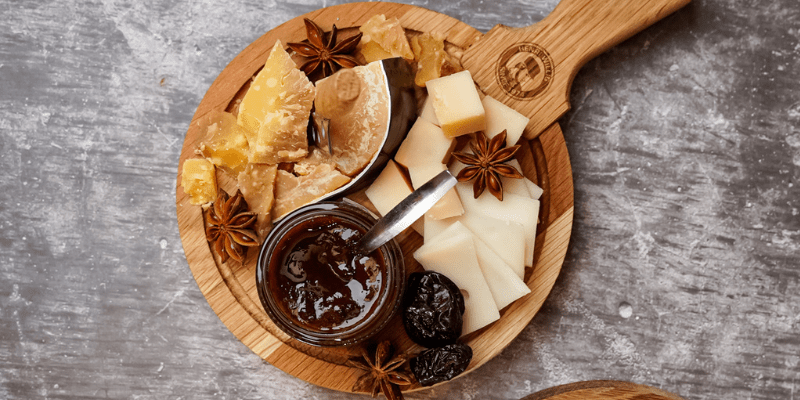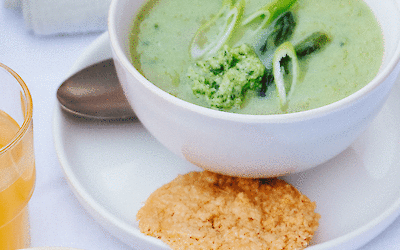Young, mature or old: what's the difference in cheese?
What exactly is the difference between young and aged cheese? And where is an aged cheese on that spectrum? In this blog article, we list the characteristics of young, mature and old cheese. You will discover how the taste and texture change the longer the cheese matures, how long each type matures and how best to use each cheese type in the kitchen. So you will soon know exactly what the difference between matured and old cheese is, the difference between matured and young cheese and you can decide which cheese will become your favourite.

Young cheese
Taste & texture
You can recognise a young cheese by its soft, creamy and mild flavour. As the cheese has only recently matured, its texture is moist, supple and unctuous. You can easily slice or spread young cheese. The taste is accessible: not too salty or sharp, but fresh and light. Perfect for those who still find an intense cheese flavour a little too overwhelming.
Maturing time
Officially, a cheese about 4 weeks old may be called a young cheese. In comparison: this is only the very beginning of the ripening process. During this short period, the creamy dairy flavours develop, but not yet the strong spiciness you taste in older cheeses.
Use in the kitchen
Thanks to its higher moisture, young cheese melts very well. This makes it ideal for sandwiches, cheese fondue or a béchamel sauce. It creates a creamy, stringy cheese spread texture. Young cheese is also a favourite on a sandwich or sandwich, precisely because it is so mild and child-friendly. When you feel like a classic Dutch sandwich or a mild cheese snack, young cheese is always a good choice.
Examples from our range
At Henri Willig, you can taste these properties for yourself in the Young Gouda. This young Gouda cheese has a soft, creamy and mild flavour that is everyone's favourite. Fans of goat's cheese are also in luck: our Young Goat's Cheese (380 g) is traditionally made from high-quality goat's milk and is characterised by its soft and creamy character. This young goat's cheese has a smooth, mild taste and fits anytime!

Mature cheese
Taste & texture
Mature cheese is the middle ground between young and old. After a longer maturation, the cheese takes on a fuller, richer flavour with a bit more spice. In fact, you can clearly taste the difference between mature and young cheese here: a mature cheese is no longer as sweet-mild as a young one, but has a slightly sharper and heartier undertone. Nevertheless, the flavour of mature cheese still remains mild enough for most people: it is less intense than really old cheese. The texture of mature cheese is slightly firmer than that of young cheese, but still quite creamy and soft. You can usually slice a mature cheese just fine without it crumbling.
Maturing time
A mature cheese has matured longer than a young one: about 4 months or ±16-18 weeks. During that extra time, enzymes further break down the milk components, creating new flavour nuances. Nevertheless, 4-5 months is still not extremely long; the cheese retains moisture and thus a creamy bite. Compared to a young cheese, however, you already taste more character, because the ripening process has converted more proteins and fats into flavourful substances.
Use in the kitchen
Due to its balance of creaminess and flavour, mature cheese is a real all-rounder. You can eat it on bread just as well as young cheese, but it adds just a little more flavour to your sandwich. Thanks to sufficient moisture, it also melts well, making it great for oven dishes, extra-flavoured sandwiches or a creamy cheese sauce. Furthermore, mature cheese comes into its own in cubes with drinks: it is firmer than young cheese, so it sticks easily on a cocktail stick, while it is milder than old cheese so it goes with many drinks.
Examples from our range
Our Henri Willig Gouda Matured 48+ is a wonderful mature cheese, aged for about four months for extra flavour development. This Gouda cheese has a slightly sharper taste than the young variety, but remains deliciously creamy and easy to slice. Perfect for those who want just a little more zest on a sandwich. Goat's cheese lover? Then try Henri Willig's mature goat's cheese. By maturing, this cheese combines the fresh, slightly sweet taste of goat's milk with a fuller, spicier profile. The result is a beautiful, balanced goat's cheese that leaves a full flavour both on the cheeseboard and in dishes.

Aged cheese
Flavour & texture
You immediately recognise an aged cheese by its intense aroma and flavour. Old cheeses have a highly developed profile: piquant, savoury and full. You often taste tones of caramel or nuts, and a pronounced saltiness due to long maturation. Small grains can form in an old cheese, these are the beloved ripening crystals (amino acid or salt crystals) that crackle between the teeth and show how ripe the cheese is. The texture is noticeably drier and harder than in younger cheeses. A good old Gouda cheese can be brittle and crumbly due to moisture loss during ripening. All this makes old cheese a real taste bomb for lovers of powerful cheese. The flavour is intense, so if you don't like strong cheese immensely or are just trying out some cheeses, definitely start with a young cheese.
Maturing time
Officially, we speak of old cheese after about 10-12 months of maturation. For a year or more, cheeses lie on the shelf to mature, with more and more moisture evaporating and the flavour concentrating. Some special cheeses mature even longer; anything above ~12 months is called perennial. The longer the maturation, the harder and spicier the cheese usually becomes. A two-year old, for example, is rock hard, barely sliceable and completely pronounced in flavour: something for the real daredevil. But even with an "ordinary" aged cheese of ~1 year, you notice the difference: compared to mature cheese, you can taste the difference between mature and old cheese immediately. The old cheese is a lot saltier, sharper and drier in texture.
Use in the kitchen
Old cheese is often enjoyed pure, so you can fully enjoy its rich flavour. On a cheeseboard , a characterful old cheese should not be missing. This can be in cubes or chunks, possibly with a lick of mustard, fig bread or a little syrup for contrast. Old cheese is also popular with drinks : a piece of old cheese goes wonderfully with a strong glass of red wine or port wine. In the kitchen, grating old cheese is great for adding flavour to dishes. A few shreds of old farmer's cheese over pasta, salad or stew can give a dish just that little bit extra because of its savoury umami taste. Note: due to the lower moisture content , old cheese does not melt as well as young cheese, so it is less suitable for a fondue or sandwich (or use a mix). But in a quiche or oven dish , you can achieve a deliciously deep flavour with grated old cheese. Think, for example, of a pumpkin quiche with aged cheese as the flavouring.
Examples from our range
Among Henri Willig's aged cheeses, Black Gouda cheese old 48+ is highly recommended for lovers of traditional Gouda aged cheese. This cow cheese has matured for at least a year and has a hard, creamy texture. Its distinctive flavour comes into its own on a warm baguette with a glass of red wine alongside. Want to try something special? Our extra old goat cheese was even awarded as the best aged cheese in the world at the World Championship Cheese Contest in Madison (Wisconsin). This unique goat cheese has matured for over a year, bursting with powerful, tangy flavour and containing crunchy crystals: perfect for the real gourmet!

Young vs mature vs old cheese
Put an older Gouda cheese next to some pieces of younger cheese. Then you can clearly see the colour difference: the old cheese is darker orange inside and has white ripening crystals on the cut surface. The younger cheese is lighter in colour and much more elastic in texture. This is because old cheese loses a lot of moisture during ripening and therefore becomes drier and more crumbly.

In the picture: an old, crumbly goat's cheese on the left, a mature goat's cheese in the middle and a young goat's cheese on the right.
To further clarify the difference between young, mature and old cheese, we have summarised the main characteristics in a table below. So you can see at a glance where these cheeses differ from each other.
| Characteristic | Young cheese | Mature cheese | Aged cheese |
| Ripening time | approx. 4-6 weeks | approx. 4 months (16-18 weeks) | approx. 12 months (1 year or more) |
| Taste | Very mild, creamy, slightly sweet | Full flavour, slightly spicy and saltier than young | Very strong, spicy and pronounced; much saltier than young |
| Texture | Very soft, unctuous, flexible; moist | Still soft and unctuous, but slightly firmer; easy to slice | Hard and dry, often crumbly; may contain crystals; difficult to slice |
| Use | Melts excellently; ideal for sandwiches, cheese fondue, sauces or as a mild spread on bread | Versatile: delicious on bread, in oven dishes, cheese sauces or cubed to accompany drinks | Best enjoyed pure in cubes/chunks with a cheeseboard or drinks; also grated in dishes for extra flavour (less suitable for melting) |
Taste the difference yourself!
In the end, there is only one way to really discover which cheese you prefer: taste it yourself. At Henri Willig, you are welcome to experience the difference between young, mature and old cheese for yourself. Visit one of our cheese shops for a tasting, or order a nice assortment via our web shop. There is something for every cheese lover. Bon appétit and much tasting pleasure!
Frequently asked questions
Yes. As cheese matures for longer, lactic acid bacteria further break down the lactose. An old cheese (± 12 months) therefore contains almost no lactose anymore, while a young cheese (± 4 weeks) may still have small residual amounts. Do you have a slight lactose intolerance but still want to enjoy it? Then preferably choose mature or old cheese.
Also read our blog article on lactose and goat's cheese!
Old cheese tastes the saltiest. The salt content per 100 g hardly changes, but moisture evaporates during longer maturation. As a result, the salt concentrates and you taste it more strongly. Young cheese remains milder due to its higher moisture content; cured is exactly in between the two in terms of salt perception.
Absolutely. The higher moisture and fat fraction in young cheese makes for a smooth, creamy melt. Aged cheese still melts well but with slightly more elasticity. Aged cheese contains less moisture and more ripening crystals; it melts with difficulty and is more likely to become brittle. For a perfect cheese sauce, combine young and mature and grate old cheese over it as a flavouring.
Order via our webshop
Is this article already making you hungry?
Check out Henri Willig's delicious recipes below.
Endive with asparagus cheese and ham
Een culinaire ovenschotel met een voorjaars-twist. Dankzij de Aspergekaas krijgt deze klassieker een heerlijke, frisse voorjaarsupgrade.De licht bittere smaak van witlof wordt prachtig in balans gebracht door de zachte, smeltende kaas en de hartige ham. Een eenvoudig, maar elegant gerecht - perfect voor een doordeweekse lenteavond of een gezellige weekendmaaltijd.
Cheese biscuits made from aged cheese
Cheese biscuits, cheese biscuits, cheese biscuits - how delicious they are! These savoury treats are surprisingly versatile. Serve them as a side dish with an asparagus soup or put them on the table as a snack with a well-filled cheeseboard. Cheese biscuits are easy to combine and always a success.





